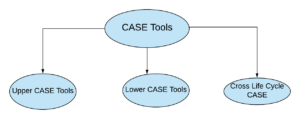Computer Aided Software Engineering Tools-Types,Advantages,Disad.
2 min read
CASE tools stand for Computer Aided Software Engineering tools.
As the name implies they are computer-based programs to increase the productivity of analyst.
They permit effective communication with users as well as other members of the development team.
They integrate the development done during each phase of a system life cycle.
Available Computer Aided Software Engineering Tools
- System requirements specification document tool.
- Data Flow diagramming tool.
- System flow chart generation tool.
- Data dictionary creator.
- E-R diagramming.
- Decision table checking.
- Formatting & checking structured English process logic.
- Screen design for data inputting.
- Form design for output.
- Database normalization & dependency information.
Types of Computer Aided Software Engineering Tools

Upper CASE Tools
CASE tools designed to support the information planning & the project identification & selection, project initiation & the planning, analysis & design phases of the system development life cycle.
Lower CASE Tools
CASE designed to support the implementation & maintenance phases of the system development life cycle.
Cross-Life Cycle Computer Aided Software Engineering
CASE tools designed to support activities that occur multiple phases of the system development life cycle.
Advantages
- Provide new systems with shorter development time.
- Improve the productivity of the systems development process.
- Enhance the quality of the systems development process.
- Improve worker skills.
- Raise the portability of new systems.
- Improve the management of the systems development process.
Disadvantages
- High cost of purchasing CASE.
- The high cost of training personnel.
- Low organization confidence in the IS department to deliver high-quality systems on time and within budget.
- Lack of methodology standards within the organization.
- Viewing CASE as a threat to job security.
- Lack of confidence in CASE products.
Hope you liked this Article. Keep visiting Mentor Way for more articles like this.



